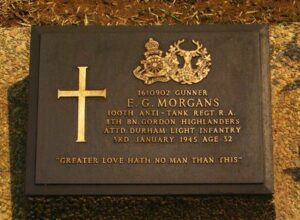Bronant is a hamlet in the rural heart of Ceredigion, which lies on the A485 road which runs north from Tregaron to Llanilar, and falls within the community of Lledrod. The Cors Caron national nature reserve lies three miles to the southeast, and the Roman road of Sarn Helen which passes to the east of the hamlet. During August 1919 the trustees of Bronant Chapel began work on securing the lease of the disused school building in order to create a war memorial hall and at some time after that, erected a war memorial plaque to honour the eight local men who fell during the Great War. A second plaque was erected after the end of the Second World War, to commemorate a further two local men who fell. The prior existence of the plaques is known, but their current location is presently unknown.
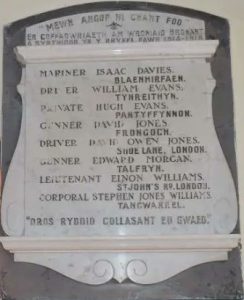
The Great War, 1914-1918
Isaac Davies, Stoker 1st Class, SS/101591, Royal Navy. Isaac was born on 9 April 1880, the son of John Davies and Catherine Davies (nee Jenkins), of Blaenhirfain, Bronant. He left home as a young man to work as a collier in South Wales, and on 30 April 1901 married Catherine James. The couple then set up home together at 1, Mound Road, Pwllgwaun. Isaac left Pontypridd to enlist into the Royal Navy in 1905 and over the coming years served aboard several ships, notably HMS Terrible and HMS Charybdis, with periods of shore postings in between. He left the Royal Navy in 1910, returning home to his wife at Pontypridd, but remained a member of the Royal Fleet Reserve. Following the outbreak of war, Isaac was mobilised and posted aboard the Edgar-class cruiser, HMS Hawke, which was an old training ship which had been brought back into service to join the 10th Cruiser Squadron in the North Sea. On 15 October 1914 Hawke was on patrol off Aberdeen when she was struck by a torpedo which had been fired by the famous German submarine U-9, and capsized with the loss of 524 officers and men. Isaac was 34 years old when he died that day. He has no known grave but the sea, so is commemorated on the Chatham Naval Memorial, Kent.
Evan Evans, Private, 69143, Royal Welsh Fusiliers. Evan was born on 10 November 1894, the son of Evan Evans and Anne Evans (nee Davies), of Tynwaun, Tregaron. He lived at Bronant prior to enlisting at Brecon into the army, and was posted to France in 1917, joining the 13th Battalion, Royal Welsh Fusiliers, which was attached to 113 Brigade, 38th (Welsh) Division. The division was holding the Canal Bank sector at Boesinghe, which it had taken over following its epic assault upon Mametz Wood the previous year. The infantry battalions of the Division then began carrying out the normal pattern of rotation in the trenches, four days in the front, four in support and four in reserve, whilst also working on trench improvement, digging new trenches, and also carrying out regular patrols and trench raids. On 31 July 1917 the Division launched its famous assault on the Pilckem Ridge, capturing Iron Cross and reaching its objective of the Steenbeek, then played a supporting role in the Battle of Langemarck. The Division was transferred to the Sailly-sur-la-Lys sector in September, and remained in the area over the winter before being moved to positions north of Albert, at Bouzincourt Ridge, at the end of March 1918, relieving the battered 2nd and 47th Divisions. It held this sector, again carrying out minor operations and trench raids, over the coming months. Evan was posted as missing, presumed killed, at Boesinghe on 7 April 1918. The remains of the 23-year-old were later recovered and he was buried in Bouzincourt Ridge Cemetery, Albert, France. Evan is not commemorated on the Bronant memorial. A brother, James Evans, spent over two years as a POW in Germany.
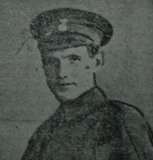
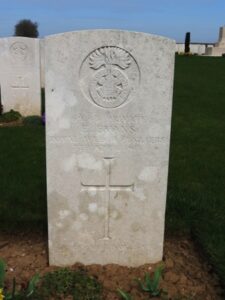
Hugh Evans, Private, 320718, Welsh Regiment. Hugh was born at Ystradfodwg in 1888, the son of David and Mary Evans. The family had returned to their native Cardiganshire by 1901 and by the time of the war resided at Pantyffynon, Bronant. Hugh enlisted at Hereford into the Glamorgan Yeomanry soon after the outbreak of war and joined the battalion in Norfolk. During March 1916 the 1/1st Glamorgan Yeomanry moved to Egypt, where it merged with the Welsh Border Mounted Brigade and formed the 4th Dismounted Brigade. On 2 February 1917 the battalion merged with the 1/1st Pembroke Yeomanry to form the 24th Battalion, Welsh Regiment, and became attached to 231 Brigade, 74th (Yeomanry) Division. The Division had formed in Egypt in January 1917 and had fought through the Palestinian Campaign, at the Battles of Gaza and the Battle and capture of Jerusalem. Due to the terrible casualties suffered by the British on the Western Front in March and April 1918 the Division was recalled to the Western Front, and arrived at Marseilles during May 1918. They then fought at the Second Battle of Bapaume during the great offensive, and fought in Flanders before returning to the Somme and fighting at the Battle of Épehy, as part of the offensive towards the Hindenburg Line. Hugh was killed in action near Gillemont Farm on 21 September 1918, aged 30. He was originally buried on the battlefield, but in August 1919 his grave was re-interred in Unicorn Cemetery, Vendhuile, France.
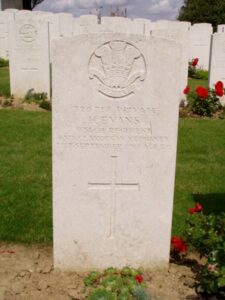
William Evans, Driver, 388623, Royal Engineers. William was born in 1889, the son of Thomas Evans and Catherine Evans (nee Morgans), of Tynreithyn, Bronant. He worked on his parents farm as a young man but prior to the war was residing in Monmouth, where he worked as a baker. William enlisted at Monmouth into the Royal Monmouthshire Royal Engineers on 9 June 1916 and spent almost twelve months on home service until embarking for France on 10 June 1917. He then spent a further twelve months serving on the Western Front, until his health began to break down and William returned to Britain on 22 June 1918. William was then diagnosed as suffering from tuberculosis, so was discharged from the army as medically unfit on 17 September 1918, returning home to his parents at Tynreithyn. Sadly he died there of tuberculosis on 8 January 1919, aged 30. Nothing further is currently known of William, as he is not commemorated as a casualty of war by the CWGC.
David Jones, Gunner, 841083, Royal Field Artillery. David was born in 1887, the son of Daniel Jones and Elizabeth Jones (nee Davies), of Frongoch, Bronant. He worked on his parents farm prior to enlisting at Aberystwyth into the Royal Field Artillery, and was posted to D Battery, 70th Brigade, Royal Field Artillery. David was then posted to Bruford to join the newly formed 323rd Siege Battery Ammunition Column, Royal Garrison Artillery in April 1917. The Ammunition Column embarked for France with the 323rd Siege Battery soon afterwards and moved to Proven, in the Ypres Salient. Over the coming months the battery supported the infantry assault upon the Passchendaele Ridge, then in October 1917 transferred to positions in Northern France, where it remained over the coming months. On 21 August 1918 the Allies launched a great offensive along the Somme front and began driving the Germans back towards the Hindenburg Line. The 323rd Siege Battery moved to the Arras Sector over the coming days and began supporting an assault by the Canadian Corps against the Drocourt-Quéant Switch Line, the northernmost section of the outer Hindenburg Line defences. David was killed in action here on 1 September 1918. The 31-year-old is buried in Fauborg D’Amiens War Cemetery, Arras, France.
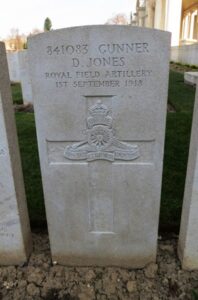
David Owen Jones, Gunner, 168380, Royal Field Artillery. David was born in Shoe Lane, London in 1897. By 1911 he was residing at Hafodlas Isaf, Llangwyrfron, with his aunt and uncle, Daniel Jones and Margaret Jones (nee James). David worked on the family farm prior to enlisting at Aberystwyth into the Royal Field Artillery, and was posted to France at some time in 1916 with the 23rd Battery, 40th Brigade, Royal Field Artillery, which was attached to the 3rd Division. David probably fought on the Somme on 1916, and moved to Ypres with the Division the following year. David was wounded at Ypres, and died of his wounds at the 10th Casualty Clearing Station, Remi Sidings, Lijssenthoek on 13 October 1917. The 20-year-old is buried in Lijssenthoek Military Cemetery, Belgium.
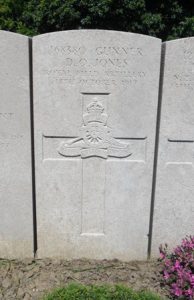
Edward Morgan, Gunner, 76579, Royal Field Artillery. Edward was born in 1887, the son of Thomas Morgan and Elizabeth Morgan (nee Jones), of Talfryn, Bronant. He worked as a shop assistant in Bermondsey prior to the war. Edward enlisted in London into the Royal Field Artillery, and was posted to France, joining B Battery, 223rd Brigade, Royal Field Artillery, which was attached to the 63rd (Royal Naval) Division. The Division moved to France from service at Gallipoli in 1916, arriving at Marseilles between 12 and 23 May, and moved to positions on the Somme, where it took part in the Battle of the Ancre, and the resulting Operations on the Ancre. In April 1917 the Division was at Arras, and fought at the Second Battle of the Scarpe, where it captured Gavrelle. The division then fought at the Battle of Arleux, before moving north to Ypres, where it took part in the Second Battle of Passchendaele. Its next major action was at Cambrai, during the Action of Welch Ridge, and the division remained in the Cambrai sector over the final winter of the war. At dawn on 21 March 1918 the sector was hit by an intensive artillery bombardment, before elite German stormtroopers attacked the Allied lines, along the section of front running south from Croisilles to La Fère. Edward was wounded during the ensuing fighting that morning, and died of his wounds later that day, on 21 March 1918. The 31-year-old is buried in Rocquigny-Equancourt Road British Cemetery, Manancourt, France.
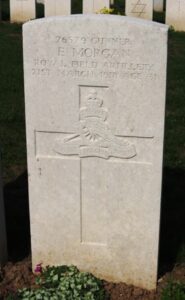
Einon Williams, Lieutenant, Royal Engineers. Einon was born on 2 November 1896, the son of Thomas and Mary Williams, of 76, St. John’s Road, New North Road, London. He was educated at the L.C.C. School of Engineering and at Finsbury College, City of London before taking up a role at the Great Western Railway Works at Swindon, where he continued his training as an engineer. He was commissioned as Second Lieutenant into the Wiltshire (Fortress) Engineers, Royal Engineers in September 1915, and was posted to France in March 1917, joining the London Division Engineers. Einon was gassed in France, and returned to England to recuperate, before resuming his military duties at the officers’ camp at Esher, where he was engaged in training cadets. Sadly he became ill and died of influenza and pneumonia on 28 October 1918. The remains of the 21-year-old were brought home for burial in Bronant Calvinistic Methodist Chapelyard.
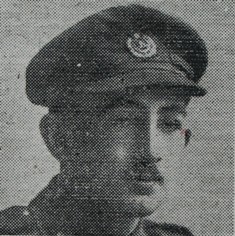
Stephen Jones Williams, Corporal, 22175, Royal Welsh Fusiliers. Stephen was the son of John and Sarah Williams, of Tanquarrel, Bronant. He lived in London prior to the war and enlisted there into the 15th Battalion, Royal Welsh Fusiliers (1st London Welsh), which was attached to 113 Brigade, 38th (Welsh) Division. On 3 December 1915 the battalion moved to France, and the entire Division moved to the Fleurbaix sector, where it was initiated into trench warfare. During June 1916 the Division marched south to the Somme, and on 7 July 1916 attacked Mametz Wood. The initial attack failed, and it was three days later, on 10 July, that a fresh attack was mounted. After two days of heavy hand to hand fighting within the wood, the Germans withdrew, and the battered Welshmen moved via Hébuterne to Boesinghe, on the Yser Canal, where it remained until launching its attack on Pilckem Ridge on 31 July 1917. Stephen was killed in action near the Steenbeek on 4 August 1917, aged 24. He has no known grave and is commemorated on the Ypres (Menin Gate) Memorial, Belgium.
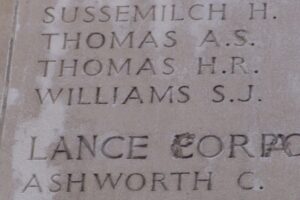
World War Two, 1939-1945
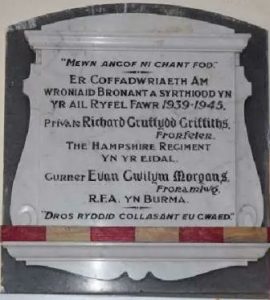
Richard Griffiths, Private, 14615740, Hampshire Regiment. Richard was born in 1913, the son of Thomas Griffiths and Elizabeth Griffiths (nee Davies), Tycerrig, of Bronant. The family later resided in Frorfelen, Bronant. Richard enlisted into the army and was posted to the 2/4th Battalion, Hampshire Regiment, which moved to North Africa as part of the 46th Division in January 1943 to take part in Operation Torch. On 9 September 1943 the division took part in the landings at Salerno, and began the move through Italy, fighting in heavily defended terrain. Richard was killed at Monte Cassino on 12 May 1944, aged 30, and is buried at Cassino War Cemetery, Italy.
Evan Gwilym Morgans, Gunner, 1610902, Royal Artillery. Evan was born in 1912, the son of Benjamin Morgans and Mary Morgans (nee Lewis), of Brynuchaf, Bronant. He married Ethel May Cane while living in London in 1935. Evan enlisted into the army and was posted to the 100th (8th Bn. The Gordon Highlanders) Anti-Tank Regiment, Royal Artillery. He was later posted to the Far East, and was attached to the Durham Light Infantry. Evan died in Burma on 3 January 1945, aged 32, and is buried in Taukkyan War Cemetery, Myanmar. The photograph is courtesy of Tony Beck.
